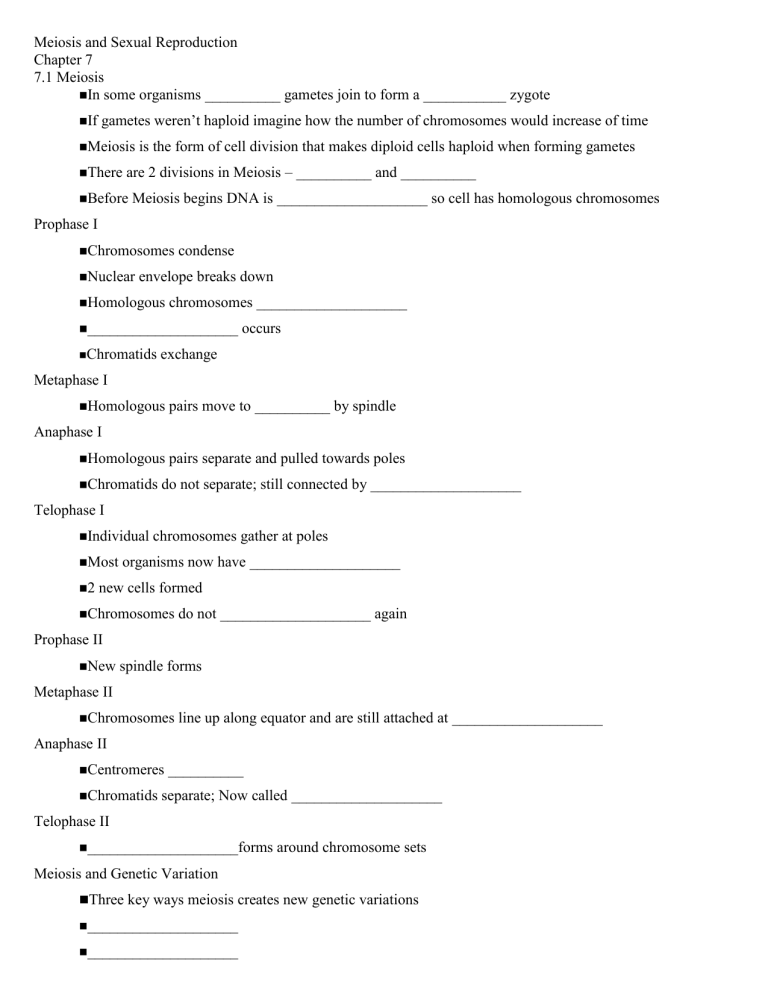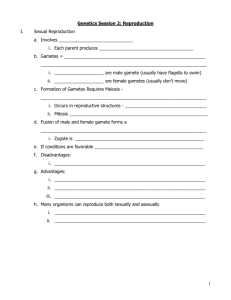Meiosis and Sexual Reproduction

Meiosis and Sexual Reproduction
Chapter 7
7.1 Meiosis
In some organisms __________ gametes join to form a ___________ zygote
If gametes weren’t haploid imagine how the number of chromosomes would increase of time
Meiosis is the form of cell division that makes diploid cells haploid when forming gametes
There are 2 divisions in Meiosis – __________ and __________
Before Meiosis begins DNA is ____________________ so cell has homologous chromosomes
Prophase I
Chromosomes condense
Nuclear envelope breaks down
Homologous chromosomes ____________________
____________________ occurs
Chromatids exchange
Metaphase I
Homologous pairs move to __________ by spindle
Anaphase I
Homologous pairs separate and pulled towards poles
Chromatids do not separate; still connected by ____________________
Telophase I
Individual chromosomes gather at poles
Most organisms now have ____________________
2 new cells formed
Chromosomes do not ____________________ again
Prophase II
New spindle forms
Metaphase II
Chromosomes line up along equator and are still attached at ____________________
Anaphase II
Centromeres __________
Chromatids separate; Now called ____________________
Telophase II
____________________forms around chromosome sets
Meiosis and Genetic Variation
Three key ways meiosis creates new genetic variations
____________________
____________________
____________________
Independent Assortment
Most organisms have more than 1 chromosome
In humans the gamete gets 1 chromosome from the ____________________
Which of the pair you get is chance
This random distribution is called Independent Assortment
Mathematically 2
23
= over ____________________combinations
Crossing Over
Portion of 1 homologous chromosome is __________and __________ with the corresponding portion of its homologous partner
Random Fertilization
What egg and sperm meet is also completely random
Mathematically that means that the possible combinations of the sperm (about 8.3 million) can be multiplied by the combinations for the egg (about 8.3 million) giving ____________________possible combinations
Meiosis generates variation in a species very quickly
Pace of evolution is __________ due to variation
A + B = C, a new individual not identical to its parents
Gametogenesis – Formation of Gametes
____________________ – sperm production occurs in testes
Diploid cell increases in size and becomes immature germ cell
Meiosis I = 2 immature sperm cells
Meiosis II = 4 haploid cells
Develop __________ and become sperm
____________________ – egg production occurs in ovaries
Diploid cell increases and becomes germ cell
Meiosis I = after cytokinesis cytoplasm is not equally divided
Smaller one called ____________________
Meiosis II = larger cell divides again, again cytoplasm not equally divided
Forms another polar body
Polar bodies will __________
__________ (pl. = ova) is larger cell
More cytoplasm means more ____________________









